Chandannagar- A Walk Through Tremple of French Colony
A historic riverside town, Chandannagar sits peacefully along the banks of the Ganges, offering a calming retreat from the noise of city life. Lined with vintage street lamps, shady trees, and colonial-era architecture, the town creates an ambience that feels both serene and steeped in memory. The soft rustle of the breeze and the slow pace of life here are perfect for a solo traveller like me—seeking history, beauty, and a bit of solitude.
Unlike Puducherry, its more famous cousin in the south, Chandannagar doesn’t boast colourful French cafés, winding boulevards, or well-preserved colonial quarters. And yet, it offers something beautifully subtle—a slice of French heritage tucked within a distinctly Bengali atmosphere. The charm here lies in the quiet dignity of its architecture, the local stories, and the seamless blend of two cultures that once shared this soil.
Interestingly, the name ‘Chandannagar’ is believed to be derived from the shape of the riverbank itself—curved like a crescent moon (Chand in Bengali means moon). This natural bend along the Ganges gives the town not just its name but also a picturesque setting, especially when the sunlight dances on the water’s surface at dawn or dusk.
A leisurely walk along The Strand, a scenic promenade by the river, reveals the town’s most striking features—French-era monuments, museums, colonial buildings, a clock tower, and peaceful ghats that invite you to sit, pause, and reflect. As a solo traveller, I found this walk to be one of the most enriching experiences of the journey. Here, the past feels close, the present is unhurried, and every corner has a story waiting to be discovered.
A Solo Traveller’s Journey Into the Heart of Colonial Bengal
I found Chandannagar to be a soulful escape—a place where every structure has a story, every street echoes with whispers of a bygone era, and every sunset along The Strand feels like poetry in motion. Formerly a French colony until as late as 1950, Chandannagar is one of the few towns in India where French influence is still palpable—from the names of buildings to the statues, churches, and even the local sweets with a hint of European flair.
In this travel journal, I invite you to walk with me through the “temple of French legacy”, as I unravel the forgotten tales of Dupleix House, stand beneath the historic Clock Tower, lose myself in the Sacred Heart Church, and feel the breeze at the ghats of Chandannagar. It’s not just a journey across places, but through layers of Indo-French history, blended beautifully with the warmth and culture of Bengal.
Whether you’re a heritage lover, history enthusiast, photographer, or a quiet wanderer looking for an offbeat weekend getaway near Kolkata, Chandannagar is bound to enchant you.
History of Chandannagar
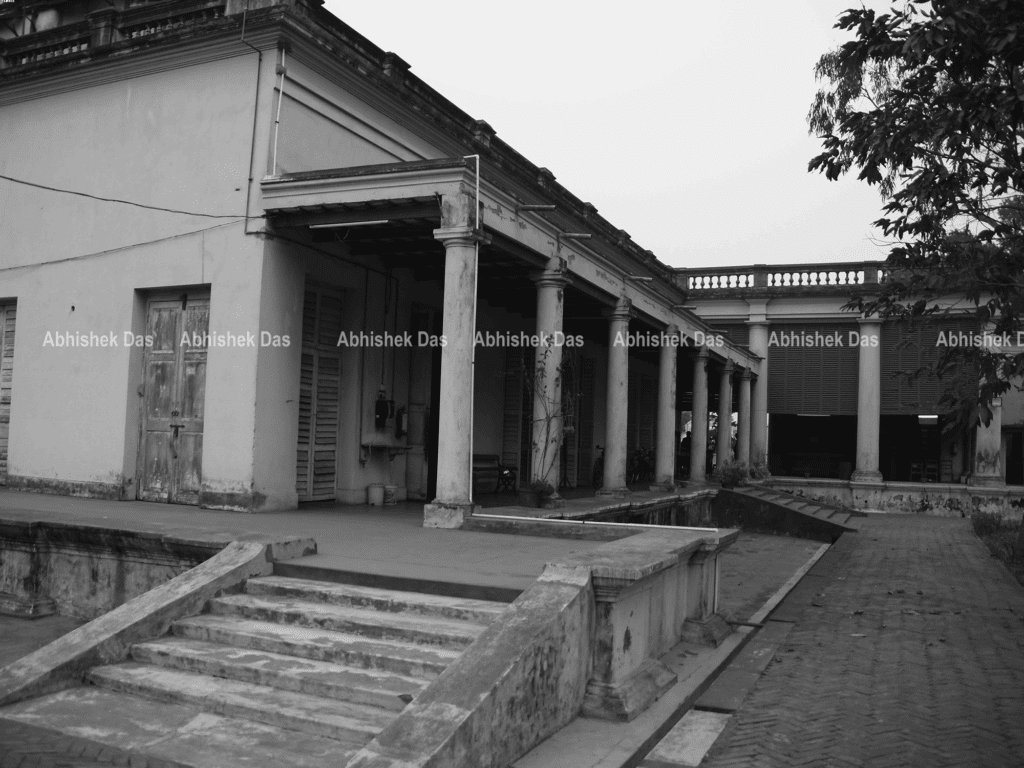
As I have a deep fascination for places where the past quietly lingers, Chandannagar felt like stepping into a forgotten page of colonial history. This charming riverside town, nestled on the banks of the Ganges, isn’t just another heritage spot—it’s a living museum of French legacy in India. Before diving into its beautiful promenades and colonial buildings, let’s take a slow walk through its glorious past.
The story of Chandannagar began in 1688, when the French East India Company purchased three villages from a Mughal Subedar. Their goal? To establish a trading post—or factory, as it was called then—on the banks of the river. What started as a modest settlement quickly evolved into a flourishing hub of commerce and diplomacy.
By 1730, the town’s fortunes changed dramatically with the arrival of Joseph François Dupleix, who became the Governor of Chandannagar. Under his visionary leadership, the town blossomed. The construction of Fort d’Orléans marked the zenith of French architectural influence in Bengal. From this fort, the French governed not just trade but also the social and cultural pulse of the colony. Chandannagar soon became the epicentre of European commerce in Bengal, attracting merchants, artisans, and adventurers from far and wide.
What many don’t know is that during this golden era, Chandannagar rivalled—and even surpassed—Calcutta in both prosperity and elegance. People often left the then-fledgling town of Calcutta to settle here, drawn by the promise of opportunity and refinement. Ironically, the bustling metropolis we now know as Kolkata was once considered the “poor cousin” of Chandannagar.
Walking through its lanes today, it’s easy to imagine the grandeur that once was—ornate colonial mansions, bustling trade offices, and Frenchmen in powdered wigs strategising over maritime maps. Yet, what makes Chandannagar truly special is not just its preserved architecture, but the invisible thread of stories that still linger in its air, waiting to be discovered by curious wanderers like myself.
A Peaceful Ambience of Chandannagar Ghat:
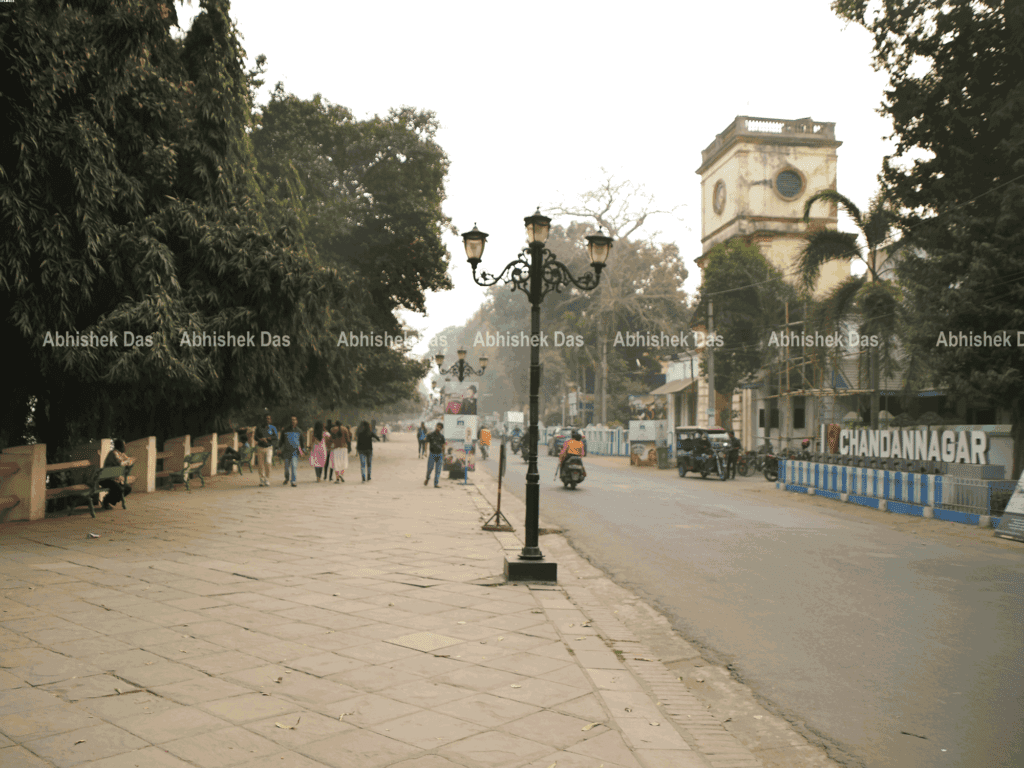
As a solo traveller always in search of quiet corners rich with stories, I found myself drawn to the peaceful ghats of Chandannagar, where the fresh breeze of the Ganges greeted me with a tranquil charm unlike any other. Here, along the riverbank, the soft rhythm of lapping water meets the whispers of colonial history, offering a French escapade with a distinctly Bengali soul.
Located just around 40 km from Kolkata, Chandannagar is arguably one of the nearest and most refreshing weekend getaways for those looking to escape the city without venturing too far. It’s the kind of place where you can explore centuries-old heritage in the afternoon and still be back home in time for dinner. But I’d recommend lingering a bit longer—because this little riverside town has much more to offer than just proximity.
Chandannagar is alive in its quiet elegance, draped in remnants of its French colonial past—from stunning architectural landmarks and age-old churches to charming promenades and unique museums. Yet, it also pulses with local energy, especially during the vibrant Jagaddhatri Pujo, a cultural festival that rivals the grandeur of Durga Puja in its own graceful way. And of course, no visit would be complete without tasting the iconic Jalbhora Sondesh, a melt-in-the-mouth sweet that’s as rich in history as it is in flavour.
My solo journey through Chandannagar was one of slow exploration and soulful discovery, as I strolled past ancient structures, sat quietly by the river, and listened to the stories whispered by the town’s heritage walls.
So come along—let me take you through the most fascinating places in and around Chandannagar, one of Bengal’s best-kept secrets and a fantastic weekend getaway near Kolkata.
You may also like: A Day in The Veil of Flowers- Khirai
The Clock Tower
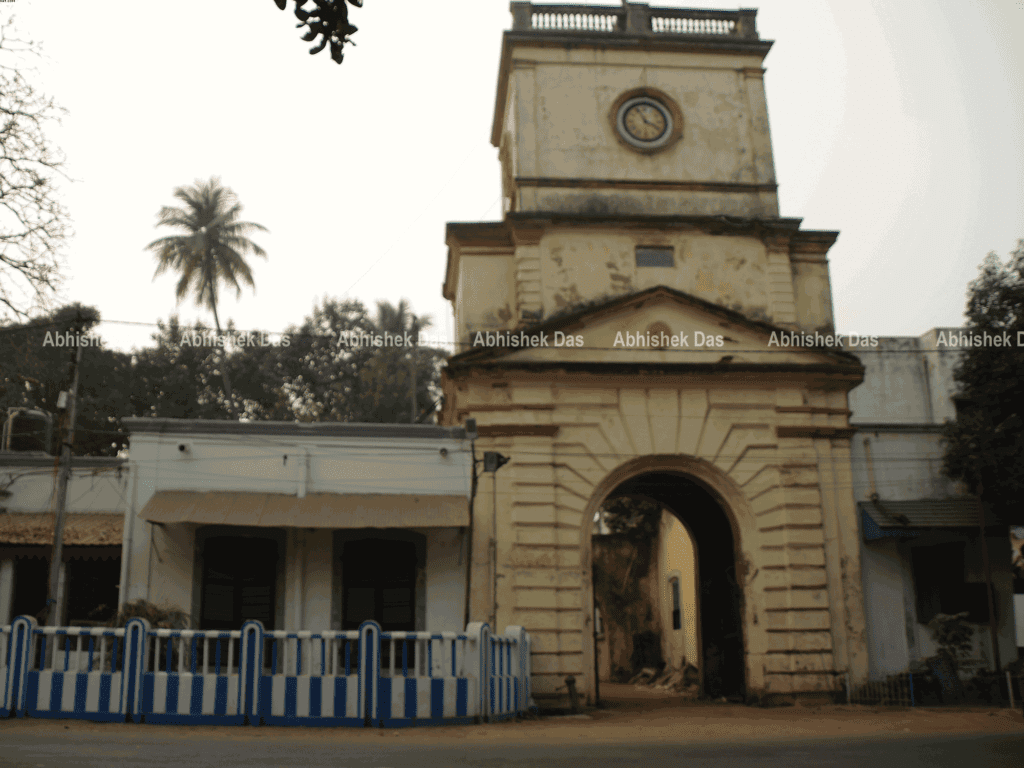
Continuing my solo walk along the picturesque Strand Road in Chandannagar, I was greeted by the towering silhouette of one of the town’s most iconic landmarks—the Clock Tower, proudly standing since 1880. This historic structure isn’t just a timekeeper; it’s a silent witness to centuries of change, a towering symbol of Chandannagar’s French colonial past.
Built during the height of French influence in the region, the tall clock tower rises from a single-storey base, now functioning as a local police station. Despite its functional repurposing, the structure retains its old-world charm. The base is styled with a prominent arched gateway and a thin block design, blending colonial architectural grace with practical civic utility. As a solo traveller with a keen eye for detail, I found myself appreciating the subtle design elements—clean lines, thoughtful proportions, and the seamless fusion of utility and beauty.
Above, the clock face, adorned with Roman numerals, ticks away with steady precision. Its constant rhythm adds an almost poetic contrast to the stillness of the surroundings. The classic design of the dial, paired with the aged hands moving in sync, feels like the heartbeat of the town—keeping time, yet unaffected by it.
What makes this spot even more tranquil is the massive banyan tree that stands just opposite the tower. Its sprawling roots and canopy of leaves form a natural shelter, offering shade to locals and travellers alike. The scene is timeless: an architectural marvel on one side, nature’s grandeur on the other—both existing in perfect harmony. For a solo traveller like me, it was the perfect place to pause, rest, and simply take in the beauty of a moment that felt outside of time.
The Clock Tower on Strand Road is more than just a historical landmark—it’s a symbol of Chandannagar’s enduring spirit and its fusion of French architecture and Indian culture. The serenity of the surroundings, enhanced by the steady ticking of the clock and the rustling leaves of the banyan tree, made it one of the most peaceful moments of my day.
Dupleix House Museum
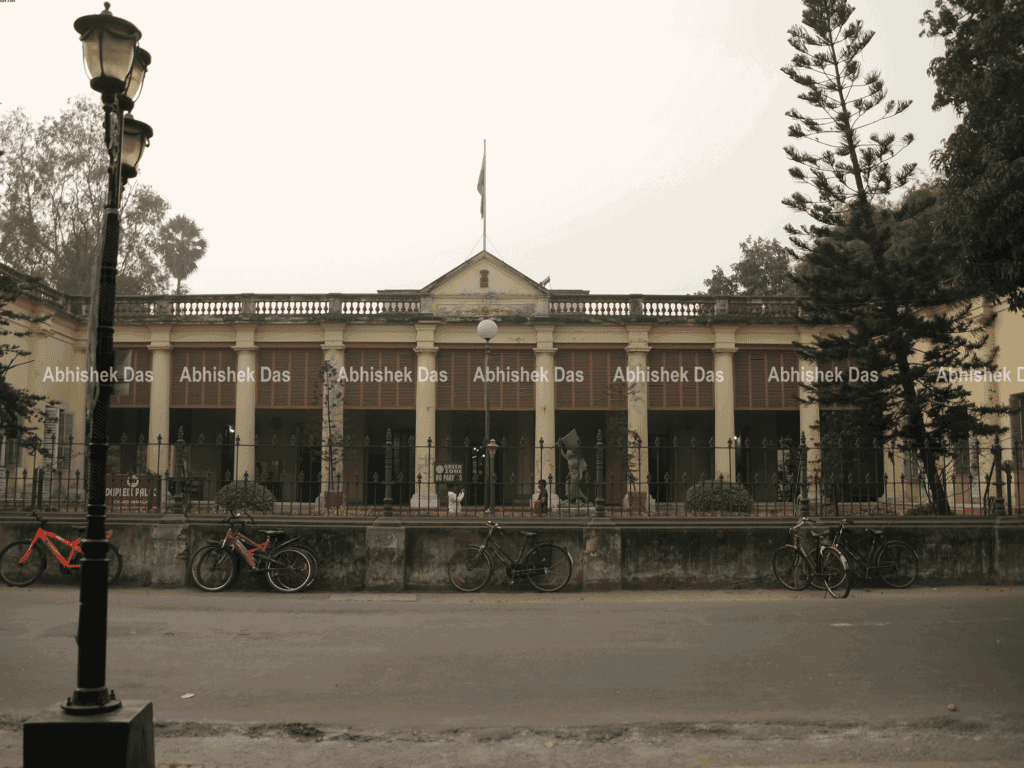
As I stepped out of the Dupleix House Museum, I couldn’t help but pause for a moment in the serene garden that surrounds the heritage building. The atmosphere here is calm and contemplative—an ideal setting for solo travellers like myself who enjoy soaking in the subtle details of a place. The sun filtered softly through the trees, casting dappled shadows across the gravel paths that led me to the striking statue of Marianne.
Positioned prominently at the entrance, Marianne—the symbolic figure of the French Republic—stands as a proud representation of liberty, justice, and civic unity. Sculpted with grace and strength, she embodies the ideals of the French Revolution: “Liberté, Égalité, Fraternité” (Liberty, Equality, Fraternity). As I stood there, I couldn’t help but reflect on how this powerful symbol feels so relevant even in today’s world, especially in a place like Chandannagar, where French and Indian histories intertwine seamlessly.
It’s rare to find such a preserved example of colonial Indo-French architecture and cultural heritage in modern-day India. The clay model of Fort d’Orléans still lingered in my thoughts—its detailed depiction of the British East India Company’s attack was more than just a visual exhibit; it was a reminder of the geopolitical struggles that once played out along the very river I had crossed earlier that day.
As a solo traveller, experiences like these are deeply personal. Walking through the museum alone gave me the space to connect with the place at my own pace, allowing every artefact and plaque to whisper its story. There was no rush—just me, history, and an old colonial town that still wears its French legacy like a quiet badge of honour.
From here, I decided to slowly make my way towards Sacred Heart Church, letting the charm of Chandannagar guide me through its narrow lanes lined with crumbling mansions, antique lamp posts, and lingering colonial echoes. This town may be small, but it holds an incredible wealth of history and culture—perfect for any traveller seeking something more meaningful than the typical tourist path.
Timing: 11 AM – 5.30 PM, Closed on Thursday and Saturday.
Entry Fee: Rs. 5 for Indian citizens and Rs. 20 for Foreigners.
You may also like: Tourist Places in Kolkata – The Heritage City
Sacred Heart Church
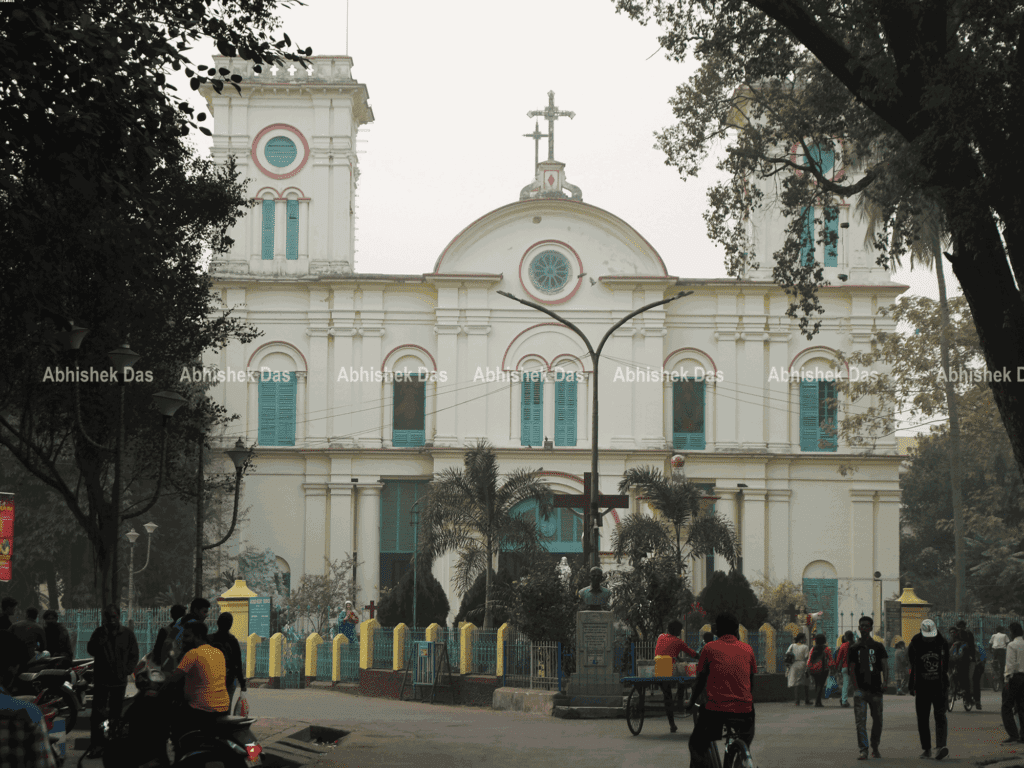
As I was wandering through the historical lanes of Chandannagar, I stumbled upon one of its most exquisite architectural landmarks—the Sacred Heart Church. This stunning double-storeyed structure, built entirely of brick, stands as a glowing testament to French heritage in India. Designed by the renowned French architect Jacques Duchatz, the church is a perfect blend of European artistry and colonial charm.
What makes the Sacred Heart Church truly remarkable is its colossal central dome, which gracefully crowns the structure. The façade features a single, prominent main entrance flanked by arched French windows, adding a classical touch to its overall symmetry. The church’s exterior alone is enough to captivate architecture lovers, but it’s what lies within that truly speaks to the soul.
Inside, the prayer hall is illuminated by stunning Belgian glass artworks positioned on the upper sections of the walls. As the sunlight filters through these vibrant stained glass windows, it casts a warm, ethereal glow that enhances the serenity of the space. The walls of the church are adorned with detailed depictions of key events in the life of Jesus Christ, rendered with such care and precision that they feel almost alive.
During prayer hours, the Sacred Heart Church transforms into a space of quiet reverence. The ambient beauty of its interior, combined with the sound of hymns and the gentle flicker of candlelight, creates an atmosphere that is both peaceful and spiritually uplifting. As a solo traveller, this moment of stillness in a centuries-old house of worship felt profoundly grounding.
Whether you’re a lover of art, architecture, or simply seeking a spiritual pause on your journey, Sacred Heart Church in Chandannagar is an unmissable stop. It not only showcases the artistic mastery of French colonial design but also stands as a living monument to faith, community, and cultural harmony.
The Strand
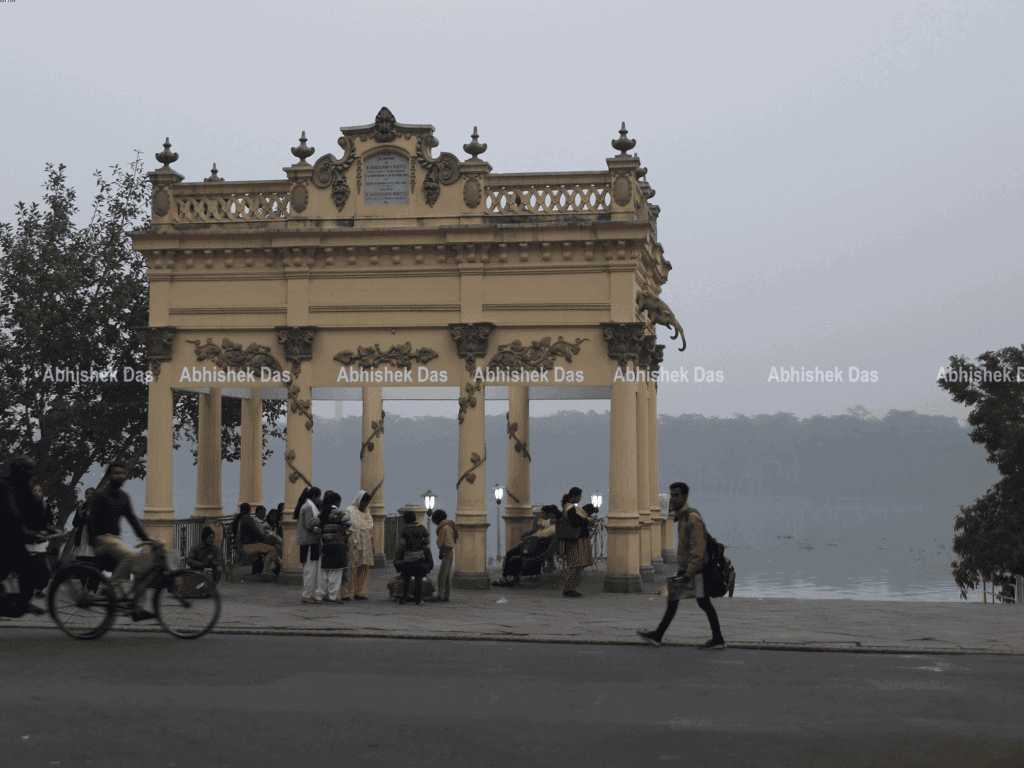
As a solo traveller seeking stories hidden in quiet corners, I found myself standing at The Strand—a beautifully decorated promenade right at the ferry point in Chandannagar. It’s not just a picturesque spot to watch boats drift lazily across the Ganges; it’s a piece of living history. One of the first things you’ll notice here is a plaque proudly displaying the powerful slogan of the French Revolution: “Liberté, Égalité, Fraternité” (Liberty, Equality, Fraternity). These ideals still echo through the colonial heart of the town, reminding you of Chandannagar’s unique French legacy.
The Strand is shaded by age-old trees and lined with classic colonial architecture, making it an ideal place to pause and reflect. As the day slowly came to an end, the horizon lit up in shades of gold and crimson. The sunset was truly breathtaking, casting shimmering reflections on the river that curves gently ahead—like a crescent moon. It’s easy to see why this town might have been named Chandannagar (Chand meaning moon, Nagar meaning town)—its riverside arc mimics the soft bend of a waxing crescent.
For film buffs, this spot may feel familiar. The Strand featured in the Bollywood thriller “Kahaani 2”, and standing there, it’s easy to understand why it was chosen—its timeless charm and cinematic aura make it a natural backdrop for storytelling.
Whether you’re a history enthusiast, a solo wanderer, or simply someone who enjoys quiet, soulful places, The Strand is a must-visit in Chandannagar. It’s not just a riverside walkway—it’s a beautiful blend of heritage, nostalgia, and natural beauty.
You may also like: 10 Offbeat Tourist Places in West Bengal
How To Reach?
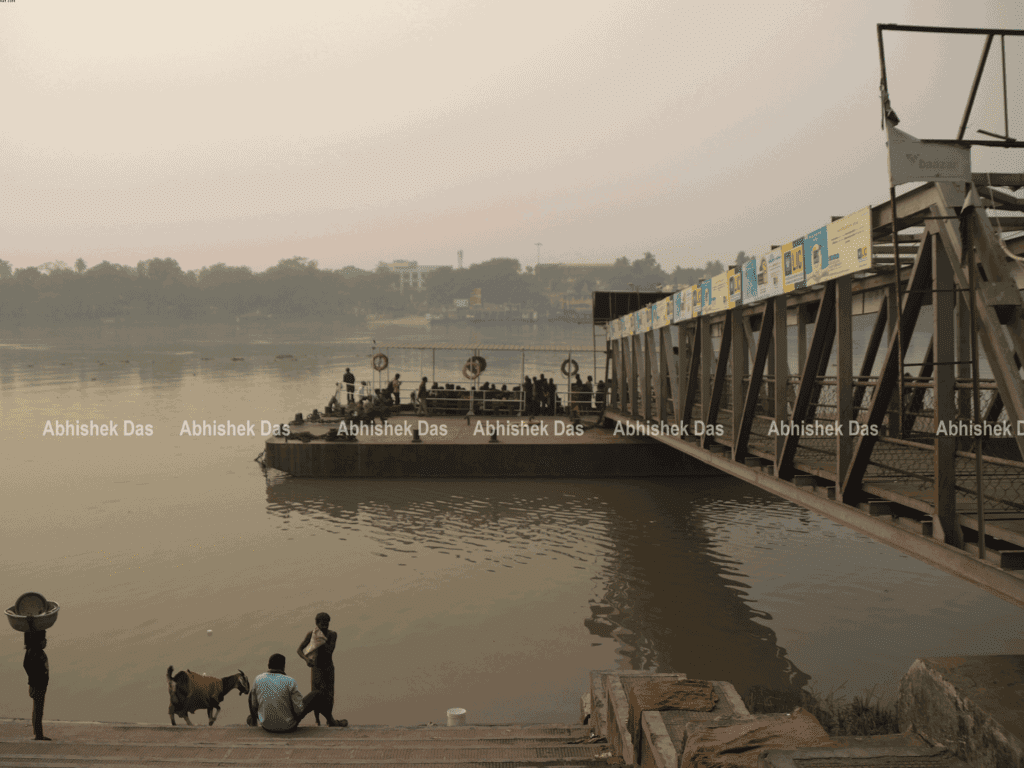
Roughly 40 km north of the bustling city of Kolkata lies the charming town of Chandannagar, a former French colony nestled along the banks of the Ganges River. Well-connected by India’s iconic Grand Trunk Road, it takes about 50 minutes to drive there from Kolkata. But as a solo traveller, I always prefer a slightly offbeat, local route—it’s part of the adventure.
I began my journey by taking a bus to Sealdah station, one of Kolkata’s main railway hubs. From there, I bought a local train ticket for just ₹10 to Shyamnagar station and hopped on the Naihati Local. The train ride took nearly an hour, giving me glimpses of suburban Bengal as we passed through stations and small towns.
Upon arriving at Shyamnagar, I made my way to platform 1 and found a shared auto headed towards Jagaddal Ghat Mor. The ride cost another ₹10. From there, it was a pleasant 15–20 minute walk to the ghat. The walk itself was delightful—quiet lanes flanked by old, worn-out buildings that seemed to whisper stories of Chandannagar’s colonial past.
At the ghat, a ferry (or jetty) service charges just ₹9 to take you across the mighty Ganges. As you float toward the other side, the serene waters and distant skyline of Chandannagar slowly come into view, setting the tone for a peaceful exploration of this historic riverside town.

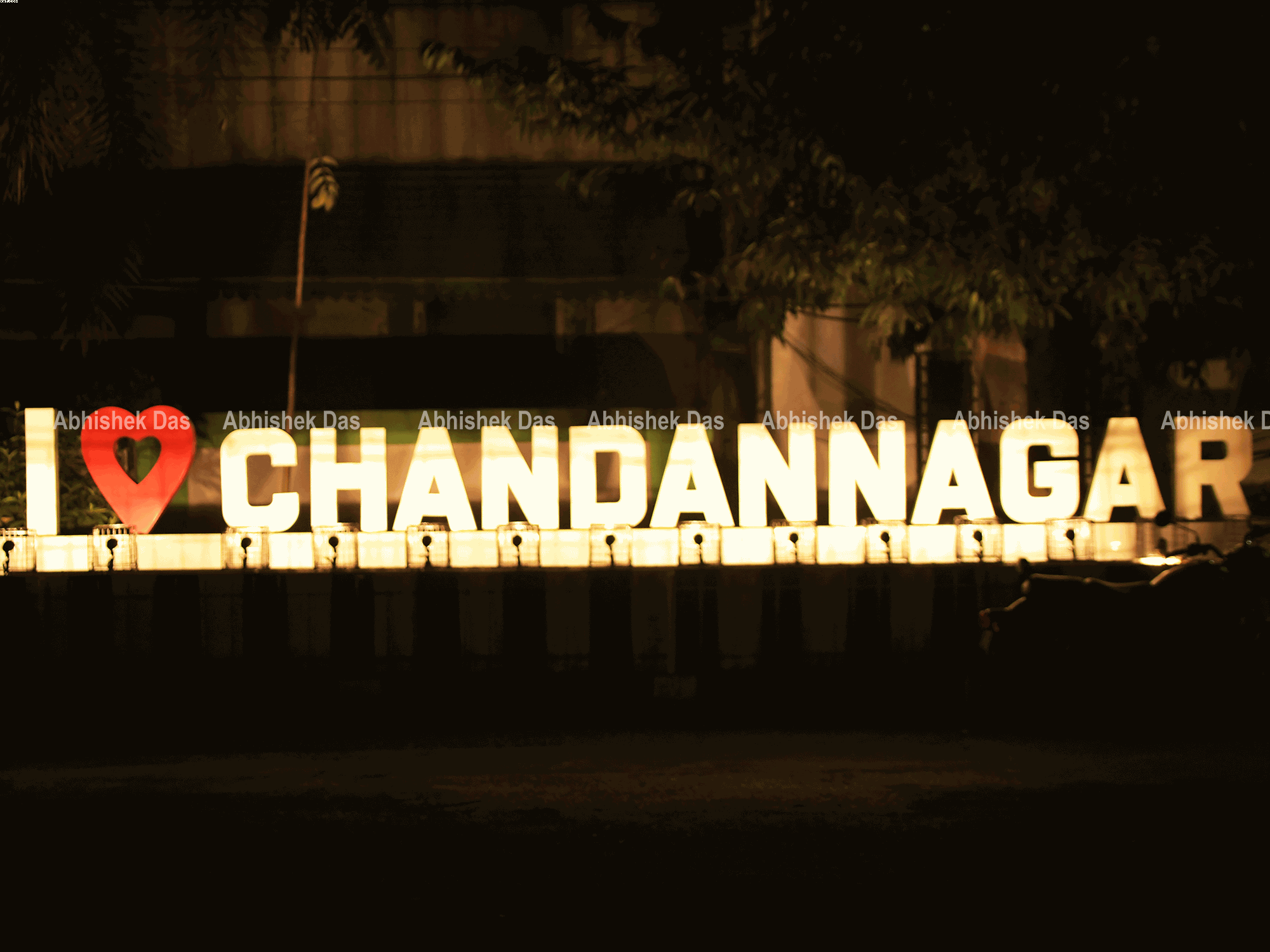
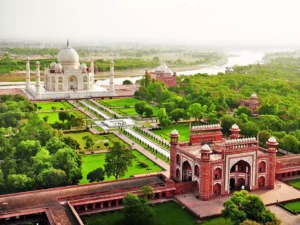
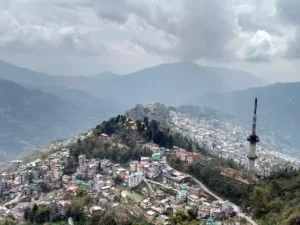



Comment (1)